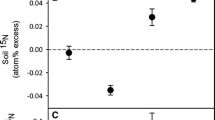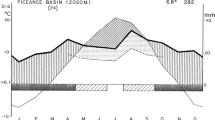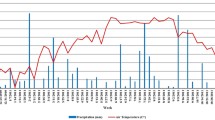Abstract
Wildlands of the United States’ Intermountain West contain recurring interspersed plant-community types; namely native sagebrush (Artemisia tridentata spp. wyomingensis Nutt.), non-native invasive cheatgrass (Bromus tectorum L.), and crested wheatgrass [Agropyron desertorum (Fisch. ex Link) Schult.]. Soil nitrogen (N) cycling in these water and N co-limited ecosystems shows very strong spatial and temporal variability, but the mechanism(s) by which these semi-arid plant communities control soil N transformations are not well understood. Over two growing seasons, we conducted field and laboratory incubations of intact soil cores (0–10 cm) with and without water added, and created a mass balance model to predict N mineralization. We found that soils under cheatgrass had the highest net N mineralization, net nitrification and soil moisture compared to soils from under the other two plant communities. Moreover, water additions to field-incubated soil cores under cheatgrass more than doubled net N mineralization (0.18 ± 0.02 vs 0.07 ± 0.01 mg N kg−1 d−1). Temperature had a small effect on net N mineralization and net nitrification, with both rates increasing by < 0.005 mg N kg−1 d−1 per °C. The model’s ability to predict N mineralization was relatively low (R2 = 0.33). However, both our model and the data themselves strongly support plant community regulation of soil N cycling through modification of soil moisture.






Similar content being viewed by others
Data availability
Data are available from the authors upon request.
Code availability
Code is available from the authors upon request.
References
Adair EC, Burke IC (2010) Plant phenology and life span influence soil pool dynamics: Bromus tectorum invasion of perennial C3–C4 grass communities. Plant Soil 335:255–269
Ahlström A, Raupach MR, Schurgers G, Smith B, Arneth A, Jung M, Reichstein M, Canadell JG, Friedlingstein P, Jain AK, Kato E, Poulter B, Sitch S, Stocker BD, Viovy N, Wang YP, Wiltshire A, Zaehle S, Zeng N (2015) The dominant role of semi-arid ecosystems in the trend and variability of the land CO2 sink. Science 348:895–899
Austin AT, Yahdjian L, Stark JM, Belnap J, Porporato A, Norton U, Ravetta DA, Schaeffer SM (2004) Water pulses and biogeochemical cycles in arid and semiarid ecosystems. Oecologia 141:221–235
Ballantyne AP, Liu Z, Anderegg WR, Yu Z, Stoy P, Poulter B, Vanderwall J, Watts J, Kelsey K, Neff J (2021) Reconciling carbon-cycle processes from ecosystem to global scales. Front Ecol Environ 19:57–65
Bezemer TM, Lawson CS, Hedlund K, Edwards AR, Brook AJ, Igual JM, Mortimer SR, Van Der Putten WH (2006) Plant species and functional group effects on abiotic and microbial soil properties and plant–soil feedback responses in two grasslands. J Ecol 94:893–904
Bishop TBB, Nusink BC, Lee Molinari R, Taylor JB, Clair SBS (2020) Earlier fall precipitation and low severity fire impacts on cheatgrass and sagebrush establishment. Ecosphere 11:e03019
Blank RR (2008) Biogeochemistry of plant invasion: A case study with downy brome (Bromus tectorum). Invasive Plant Sci Manag 1:226–238
Booth MS, Stark JM, Caldwell MM (2003) Inorganic N turnover and availability in annual- and perennial-dominated soils in a northern Utah shrub-steppe ecosystem. Biogeochemistry 66:311–330
Burke IC (1989) Control of nitrogen mineralization in a sagebrush steppe landscape. Ecology 70:1115–1126
Burke IC, Lauenroth WK, Parton WJ (1997) Regional and temporal variation in net primary production and nitrogen mineralization in grasslands. Ecology 78:1330–1340
Cable JM, Ogle K, Williams DG, Weltzin JF, Huxman TE (2008) Soil texture drives responses of soil respiration to precipitation pulses in the sonoran desert: implications for climate change. Ecosystems 11:961–979
Chen J, Stark JM (2000) Plant species effects and carbon and nitrogen cycling in a sagebrush–crested wheatgrass soil. Soil Biol Biochem 32:47–57
Cline J, Uresk D, Rickard W (1977) Comparison of soil water used by a sagebrush bunchgrass and a cheatgrass community. J Range Manag Archi 30:199–201
Conant RT, Dalla-Betta P, Klopatek CC, Klopatek JM (2004) Controls on soil respiration in semiarid soils. Soil Biol Biochem 36:945–951
Craine JM, Tilman D, Wedin D, Reich P, Tjoelker M, Knops J (2002) Functional traits, productivity and effects on nitrogen cycling of 33 grassland species. Funct Ecol 16:563–574
Crawford JA, Olson RA, West NE, Mosley JC, Schroeder MA, Whitson TD, Miller RF, Gregg MA, Boyd CS (2004) Ecology and management of sage-grouse and sage-grouse habitat. J Range Manag 57:2–19
Cregger MA, McDowell NG, Pangle RE, Pockman WT, Classen AT (2014) The impact of precipitation change on nitrogen cycling in a semi-arid ecosystem. Funct Ecol 28:1534–1544
Dou Z, Toth JD, Jabro JD, Fox RH, Fritton DD (1996) Soil nitrogen mineralization during laboratory incubation: dynamics and model fitting. Soil Biol Biochem 28:625–632
Ehrenfeld JG (2003) Effects of exotic plant invasions on soil nutrient cycling processes. Ecosystems 6:503–523
Ehrenfeld JG, Ravit B, Elgersma K (2005) Feedback in the plant-soil system. Annu Rev Environ Resour 30:75–115
Eno CF (1960) Nitrate production in the field by incubating the soil in polyethylene bags. Soil Sci Soc Am J 24:277–279
Fischer C, Leimer S, Roscher C, Ravenek J, de Kroon H, Kreutziger Y, Baade J, Beßler H, Eisenhauer N, Weigelt A, Mommer L, Lange M, Gleixner G, Wilcke W, Schröder B, Hildebrandt A (2019) Plant species richness and functional groups have different effects on soil water content in a decade-long grassland experiment. J Ecol 107:127–141
Flerchinger GN, Fellows AW, Seyfried MS, Clark PE, Lohse KA (2020) Water and carbon fluxes along an elevational gradient in a sagebrush ecosystem. Ecosystems 23:246–263
Germino MJ, Belnap J, Stark JM, Allen EB, Rau BM (2016) Ecosystem Impacts of Exotic Annual Invaders in the Genus Bromus. In: Germino MJ, Chambers JC, Brown CS (eds) Exotic Brome-Grasses in Arid and Semiarid Ecosystems of the Western US: Causes, Consequences, and Management Implications. Springer International Publishing, Cham, pp 61–95
Gill RA, Burke IC (1999) Ecosystem consequences of plant life form changes at three sites in the semiarid United States. Oecologia 121:551–563
Guntiñas ME, Leirós MC, Trasar-Cepeda C, Gil-Sotres F (2012) Effects of moisture and temperature on net soil nitrogen mineralization: a laboratory study. Eur J Soil Biol 48:73–80
Haverd V, Ahlström A, Smith B, Canadell JG (2016) Carbon cycle responses of semi-arid ecosystems to positive asymmetry in rainfall. Glob Change Biol 23:793–800
Herron PM, Stark JM, Holt C, Hooker T, Cardon ZG (2009) Microbial growth efficiencies across a soil moisture gradient assessed using 13C-acetic acid vapor and 15N-ammonia gas. Soil Biol Biochem 41:1262–1269
Hook PB, Burke IC (2000) Biogeochemistry in a shortgrass landscape: control by topography, soil texture, and microclimate. Ecology 81:2686–2703
Hooker TD, Stark JM (2008) Soil C and N cycling in three semiarid vegetation types: response to an in situ pulse of plant detritus. Soil Biol Biochem 40:2678–2685
Hooker TD, Stark JM, Norton U, Leffler AJ, Peek M, Ryel R (2008) Distribution of ecosystem C and N within contrasting vegetation types in a semiarid rangeland in the Great Basin, USA. Biogeochemistry 90:291–308
Hooper DU, Vitousek PM (1998) Effects of plant composition and diversity on nutrient cycling. Ecol Monogr 68:121–149
Kulmatiski A, Adler PB, Foley KM (2020) Hydrologic niches explain species coexistence and abundance in a shrub–steppe system. J Ecol 108:998–1008
Lama S, Velescu A, Leimer S, Weigelt A, Chen H, Eisenhauer N, Scheu S, Oelmann Y, Wilcke W (2020) Plant diversity influenced gross nitrogen mineralization, microbial ammonium consumption and gross inorganic N immobilization in a grassland experiment. Oecologia 193:731–748
Mack RN (1986) Alien plant invasion into the intermountain west: A case history. In: Mooney HA, Drake JA (eds) Ecology of Biological Invasions of North America and Hawaii. Springer, New York, New York, NY, pp 191–213
Mahood AL, Jones RO, Board DI, Balch JK, Chambers JC (2021) Interannual climate variability mediates changes in carbon and nitrogen pools caused by annual grass invasion in a semiarid shrubland. Glob Change Biol. https://doi.org/10.1111/gcb.15921
Morris KA, Stark JM, Bugbee B, Norton JM (2016) The invasive annual cheatgrass releases more nitrogen than crested wheatgrass through root exudation and senescence. Oecologia 181:971–983
Mueller KE, Blumenthal DM, Pendall E, Carrillo Y, Dijkstra FA, Williams DG, Follett RF, Morgan JA (2016) Impacts of warming and elevated CO2 on a semi-arid grassland are non-additive, shift with precipitation, and reverse over time. Ecol Lett 19:956–966
Nagy RC, Fusco EJ, Balch JK, Finn JT, Mahood A, Allen JM, Bradley BA (2021) A synthesis of the effects of cheatgrass invasion on US Great Basin carbon storage. J Appl Ecol 58:327–337
Norton JB, Monaco TA, Norton JM, Johnson DA, Jones TA (2004) Soil morphology and organic matter dynamics under cheatgrass and sagebrush-steppe plant communities. J Arid Environ 57:445–466
Norton U, Saetre P, Hooker TD, Stark JM (2012) Vegetation and moisture controls on soil carbon mineralization in semiarid environments. Soil Sci Soc Am J 76:1038–1047
Papendick R, Campbell GS (1981) Theory and measurement of water potential. Water Potential Relat in Soil Microbiol 9:1–22
Parker SS, Schimel JP (2010) Invasive grasses increase nitrogen availability in California grassland soils. Invasive Plant Sci Manag 3:40–47
Parker SS, Schimel JP (2011) Soil nitrogen availability and transformations differ between the summer and the growing season in a California grassland. Appl Soil Ecol 48:185–192
Peek MS, Leffler AJ, Ivans CY, Ryel RJ, Caldwell MM (2005) Fine root distribution and persistence under field conditions of three co-occurring Great Basin species of different life form. New Phytol 165(1):171–180
Phillips ML, McNellis BE, Allen MF, Allen EB (2019) Differences in root phenology and water depletion by an invasive grass explains persistence in a Mediterranean ecosystem. Am J Bot 106:1210–1218
Png GK, Lambers H, Kardol P, Turner BL, Wardle DA, Laliberté E (2019) Biotic and abiotic plant–soil feedback depends on nitrogen-acquisition strategy and shifts during long-term ecosystem development. J Ecol 107:142–153
Polley HW, Briske DD, Morgan JA, Wolter K, Bailey DW, Brown JR (2013) Climate change and North American Rangelands: trends, projections, and implications. Rangel Ecol Manag 66:493–511
Prater MR, DeLucia EH (2006) Non-native grasses alter evapotranspiration and energy balance in Great Basin sagebrush communities. Agric for Meteorol 139:154–163
Reichmann LG, Sala OE, Peters DPC (2013) Water controls on nitrogen transformations and stocks in an arid ecosystem. Ecosphere 4:11
Rogler GA, Lorenz RJ (1983) Crested wheatgrass: early history in the United States. J Range Manag 36:91–93
Roundy BA, Chambers JC, Pyke DA, Miller RF, Tausch RJ, Schupp EW, Rau B, Gruell T (2018) Resilience and resistance in sagebrush ecosystems are associated with seasonal soil temperature and water availability. Ecosphere 9:e02417
Saetre P, Stark JM (2005) Microbial dynamics and carbon and nitrogen cycling following re-wetting of soils beneath two semi-arid plant species. Oecologia 142:247–260
Shen W, Jenerette G, Hui D, Scott R (2016) Precipitation legacy effects on dryland ecosystem carbon fluxes: direction, magnitude and biogeochemical carryovers. Biogeosciences 13:425–439
Stark JM, Norton JM (2015) The invasive annual cheatgrass increases nitrogen availability in 24-year-old replicated field plots. Oecologia 177:799–809
Stark JM (2000) Nutrient transformations Methods in ecosystem science. Springer, New York
Su B, Shangguan Z (2019) Decline in soil moisture due to vegetation restoration on the loess plateau of China. Land Degrad Dev 30:290–299
Sullivan BW, Selmants PC, Hart SC (2012) New evidence that high potential nitrification rates occur in soils during dry seasons: are microbial communities metabolically active during dry seasons? Soil Biol Biochem 53:28–31
Trickler DL, Hall DT, Franks DC, Ferguson SK, Campbell LD, Savage PJ, Brewer JE (2000) Soil survey of Tooele area, Utah. U.S. Gov. Print. Office, Washington, DC
Vinton MA, Burke IC (1995) Interactions between individual plant species and soil nutrient status in shortgrass steppe. Ecology 76:1116–1133
Vourlitis GL (2012) Aboveground net primary production response of semi-arid shrublands to chronic experimental dry-season N input. Ecosphere 3:1–9
West NE, Young JA (2000) Intermountain valleys and lower mountain slopes. In: Barbour MG, Billings WD (eds) North American terrestrial vegetation. Cambridge University Press, New York, pp 255–284
Yan L, Chen S, Huang J, Lin G (2011) Increasing water and nitrogen availability enhanced net ecosystem CO2 assimilation of a temperate semiarid steppe. Plant Soil 349:227–240
Yang WH, Ryals RA, Cusack DF, Silver WL (2017) Cross-biome assessment of gross soil nitrogen cycling in California ecosystems. Soil Biol Biochem 107:144–155
Zhu P, Zhang G, Wang H, Zhang B, Liu Y (2021) Soil moisture variations in response to precipitation properties and plant communities on steep gully slope on the Loess Plateau. Agric Water Manag 256:107086
Acknowledgements
The authors thank Myq Larson, Sarah Smith Benanti, Toby Hooker, Carey Wicks, Casey Anderson, Ammon Anderson, Allison Czerniak, Matt Groll, Sethu Kambham, and Adrienne Marler for assistance with field and lab work. Thanks also goes to two anonymous reviewers whose comments greatly improved the manuscript. Better late than never!
Funding
This research was supported by grants from the NSF Ecosystem Studies, the USDA-NRI, and the Utah Agricultural Experiment Station.
Author information
Authors and Affiliations
Corresponding author
Ethics declarations
Conflict of interest
The authors declare no competing interest.
Additional information
Responsible Editor: Edith Bai.
Publisher's Note
Springer Nature remains neutral with regard to jurisdictional claims in published maps and institutional affiliations.
Supplementary Information
Below is the link to the electronic supplementary material.
Rights and permissions
About this article
Cite this article
Morris, K.A., Saetre, P., Norton, U. et al. Plant community effects on soil moisture and nitrogen cycling in a semi-arid ecosystem. Biogeochemistry 159, 215–232 (2022). https://doi.org/10.1007/s10533-022-00922-y
Received:
Accepted:
Published:
Issue Date:
DOI: https://doi.org/10.1007/s10533-022-00922-y




